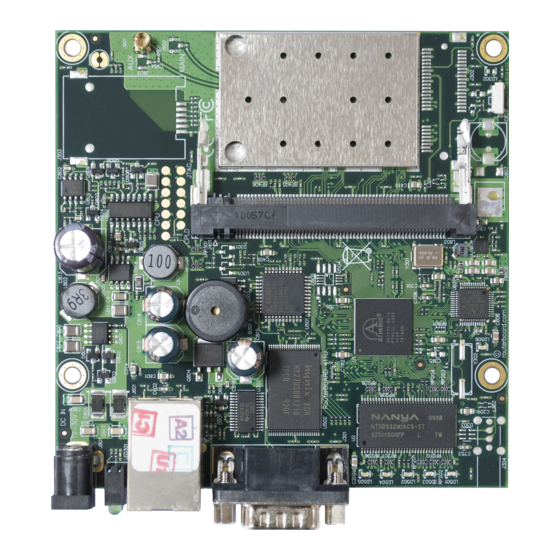
Advertisement
Quick Links
RouterBOARD
4 11AR
Quick
S etup
G uide
a nd
W arranty
I nformation
Assembling
t he
H ardware
First
u se
o f
t he
b oard:
Insert
the
MiniPCI
card.
RouterBOARD
411AR
provides
one
•
MiniPCI
s lot
o n
t he
t op
o f
t he
b oard
Connect
a ntenna
c ables
t o
t he
M iniPCI
c ard
a nd/or
t o
t he
b uilt
•
in
W iFI
c ard's
M MCX
c onnector
Install
the
board
in
a
case
and
connect
other
peripherals
and
•
cables.
Plug
i n
p ower
c able
t o
t urn
o n
t he
b oard.
•
Powering
The
board
accepts
powering
from
either
the
power
jack
or
the
LAN1
Ethernet
p ort:
direct-‐input
power
jack
J7
(5.5mm
outside
and
2mm
inside
diameter,
female,
pin
positive
plug)
accepts
•
9..28V
D C
( overvoltage
p rotection
s tarts
a t
2 8V).
LAN1
Ethernet
port
J8
accepts
9..28V
DC
input
(at
the
board;
higher
voltage
needed
to
compensate
for
•
power
loss
on
long
cables;
at
least
18V
suggested)
from
non-‐standard
(passive)
Power
over
Ethernet
injectors
(no
power
over
datalines).
The
board
does
not
work
with
IEEE802.3af
compliant
48V
power
injectors.
The
m aximum
o utput
o f
t he
p ower
s upply
a vailable
f or
e xtension
c ards
i s
n ormally
1 0W
( 3.0A).
Booting
p rocess
First,
RouterBOOT
is
started.
It
displays
some
useful
information
on
the
onboard
RS232C
asynchronous
serial
port.
The
serial
port
is
set
by
default
to
115200bit/s,
8
data
bits,
1
stop
bit,
no
parity.
Note
that
the
device
does
not
f ully
i mplement
t he
h ardware
( RTS/CTS)
f low
c ontrol,
s o
i t
i s
s uggested
t o
t ry
t o
d isable
h ardware
f low
c ontrol
in
the
terminal
emulation
program
in
case
the
serial
console
does
not
work
as
expected,
and
if
it
does
not
help,
make
a
new
cable
using
the
pinout
given
in
the
User's
manual.
The
loader
may
be
configured
to
boot
the
system
from
the
onboard
NAND,
and/or
from
network.
See
the
respective
section
of
User's
manual
on
how
to
configure
booting
s equence
a nd
o ther
B IOS
p arameters. http://wiki.mikrotik.com/wiki/First_time_startup
DHCP
or
BOOTP
(configurable
in
loader)
protocols
allow
the
RouterBOARD
411AR
device
to
get
an
initial
IP
address,
and
provide
the
address
of
a
TFTP
server
to
download
an
ELF
boot
image
from.
It
is
especially
useful
for
software
installation.
See
the
User's
manual
for
more
information
and
protocol
details.
Note
that
you
must
connect
the
RouterBOARD
you
want
to
boot
and
the
BOOTP/DHCP
and
TFTP
servers
to
the
same
broadcast
domain
( i.e.,
t here
m ust
n ot
b e
a ny
r outers
b etween
t hem
–
t hey
m ust
b e
o n
t he
s ame
E thernet
s witch).
See
w
ww.routerboard.com
f or
m ore
i nformation.
C ontact
s upport@mikrotik.com
f or
s upport
q uestions
20/08/13
Advertisement

Summary of Contents for RouterBOARD 411AR
- Page 1 s equence a nd o ther B IOS p arameters. http://wiki.mikrotik.com/wiki/First_time_startup DHCP or BOOTP (configurable in loader) protocols allow the RouterBOARD 411AR device to get an initial IP ...
- Page 2 a nd r egistered t rademarks a ppearing i n t his m anual a re t he p roperty o f t heir r espective h olders. Hardware. MikroTik warrants all RouterBOARD series equipment for the term of fifteen (15) months from the ...
- Page 3 Undertegnede M IKROTIK, L TD. e rklærer h erved, a t f ølgende u dstyr R OUTERBOARD o verholder d e v æsentlige k rav o g ø vrige r elevante k rav i d irektiv 1 999/5/EF. Hiermit erklärt MIKROTĪKLS SIA dass sich das Gerät ROUTERBOARD in Übereinstimmung mit den grundlegenden Anforderungen und den übrigen einschlägigen ...
Need help?
Do you have a question about the 411AR and is the answer not in the manual?
Questions and answers